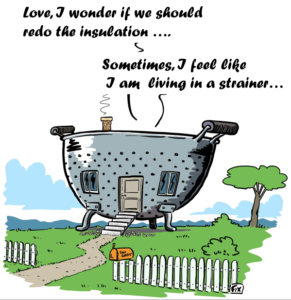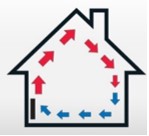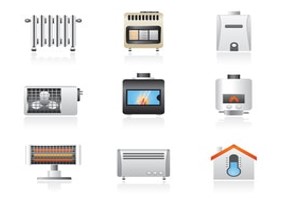HEATING
information sheet 15
Make your house healthy (dry) and warm
Cold homes are not a curse, but still a harsh reality. You will find here the basics of heating, tips to keep your house warm, and most important: a step by step process to help you find the appropriate heating system for you, to make your home comfortable and energy efficient.
Heating System Basics
What does a heating system do?
It replaces heat that is lost through the shell of your house. How much energy your heating system requires to replace that ‘lost heat’ depends on four factors: where the house is located (in colder places, the house will lose more heat); how big the house is; the thermal efficiency of the house; and how energy efficient the heating system is.
You can’t do much about the first factor. All other things being equal, the bigger the house, the more energy it will take to heat it. Chances are, you’re not going to decrease the size of your house.
As for the efficiency of your house, make sure your ceiling, underfloor and windows are well insulated and free of draughts (these measures are addressed in the others info sheets) otherwise heating your home will be like trying to pour water into a leaky bucket….
The right temperature
Whilst ideal comfort temperatures are often a personal preference, the World Health Organization (WHO) recommends, for beneficial health, a minimum indoor temperature of 18˚C and ideally 21°C if babies or elderly people live in the house. (You can drop that down to 16°C at night, if you’re really looking to save on your heating bill)
Remember the basics
- Hot air rises / cool air drops > floor level heating preferred.
- Heat moves from hot to cold (Thermodynamics law 2) Not the other way around!
- Heat goes where the air flows >so, fix the draughts.
- Keep your house dry and save money!
Tips: Cold dry air is cheaper and easier to heat than cold damp air, as you don’t have to heat the air + the excess water in it. So, use a dehumidifier prior heating, if needed.
efficiency & Carbon
The efficiency of a heater refers to how efficiently energy is converted into heat. All electric resistive heaters have a 1:1 ratio (100% efficient). Heat pump are super achievers with a 100-400% of efficiency reached as they have a Coefficient Of Performance (COP) of 1:1 up to 1:4 when used at the right time! (Above 8°C outside, most Heat Pumps get a COP of 4!)
If you can, reduce you’re carbon footprint by steering away from fossil-fuel (diesel coal and gas) heating options. They produce more carbon emissions Equiv. than all types of electric heaters, as NZ electricity is 79% low carbon mainly coming from renewable sources with a top score of 100% renewable for the South Island. (Solar / wind / hydro)
Low emission wood burners and pellet fires are nowadays very energy efficient too (between 65 to 80% of the energy is transformed into heat), and could also have a low carbon impact when the wood comes from a renewable forestry.
choosing your heating system
Below, is step by step process to help you find the most appropriate system for you and your home. this is applicable for new and existing homes.
STEP 1 – what do you prefer?
There are 2 types of heat used to heat your home:
| 1 > Radiant heat:
|
Radiation heaters, like the Sun, heat the surfaces and the objects (including people’s skin and clothing) by infrared waves of heat from the heater source. The air in between the heating source and the object is not heated. |
Radiation heating sources: The Sun (passive solar) / Wood-burners / Radiators / Panel heaters / underfloor heating.
| 2 > Convection heat:
|
In convection heating, air is heated when it comes into contact with hot surfaces in the heater. People feel warmer because of the higher air temperature. Some convection heaters use a fan to draw the cool air into the device. |
Convection heating sources: Heat pump / Convector / Fan heater / Pellet fire (fan) / Convector-radiator.
> So, which one would you prefer?
STEP 2 – how does your house retain the heat?
A house can retain the heat in two ways:
1- With a moderate to high level of thermal mass. (Concrete / tiles / solid timber etc) Old villas for example were designed with a high level of thermal mass (timber lining in the corridors, solid timber floors thick plaster) and works perfectly with a radiant heat source, like logs burners or the sun. The heat is stored in the thermal mass and then released later little by little. This is a slow heating process.
2- By being airtight. New build are considered being relatively airtight (around 3 to 5 air exchange per hour) and works perfectly with a convector heat source like a heat pump. The heat pump will primarily heat the air, and because the house is designed to be airtight, the heat will stay in.
> So, how is your house designed to retain the heat?
> Is this compatible with step one? (Well, it should!)
Tips: If you are building a new home, you can choose what type of heat you like and design your house to work with it.
If you have an existing home, choose your heating system wisely, old villas are far from airtight, so if you choose a heat pump system, address the air leakage (draught proofing) first.
STEP 3 – the heating system
1> Are you active or passive with your system?
Passive: The heating device works on auto pilot: It has a timer and a digital thermostat, to ensure the delivery of heat when you need it.
Active: The heating device depends on you to run: like a log burner, it requires your interaction to start, and keep running.
2> centralized VS decentralized
Centralized: One system for the whole house, like a ducted heat pump, a log burner combined with a heat-transfer system or central-heating with radiators (or underfloor heating)
Decentralized: It is a room by room system approach.
One device per habitable space; like a pellet fire in the living spaces and radiators in the other rooms, like bedrooms.
> So, how do you interact with your heating device?
> Is it ”all for one”, or ”one for all”?
Tips: Some heating devices are designed to work by themselves (like underfloor heating) whereas others are multi-functional like heat-pumps: It can works on manual and automatic.
STEP 4 – find the adequate system
| Now, you know what you like, how your house works, and how you want to interact with your heating system, you just need to find the device that ticks all the boxes! Here few examples: |
1 > Concrete blocks homes have a lot of thermal mass, radiant heat will suit the house best, preferably with an automatic system > possible options: (wifi connected) pellet-fire with radiators in bedrooms, or central heating (hot water radiators, or underfloor)
2 > New builds are relatively airtight, so a convection heat system will work well. If the new build has some thermal mass, radiant heat Is also an option, so you have choices!
If you still don’t know what’s best for you, ask a specialist! Ask your local Eco design Advisor. www.ecodesignadvisor.org.nz
Download PDF



